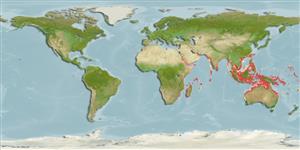Elasmobranchi (squali e razze) (sharks and rays) >
Myliobatiformes (Stingrays) >
Dasyatidae (Stingrays) > Urogymninae
Etymology: Pateobatis: Combination of Latin 'pateo' for 'lie open, be exposed' and 'batis' for skate, ray or flatfish; referring to the eclectic nature of members of this group..
Environment: milieu / climate zone / depth range / distribution range
Ecologia
marino; salmastro demersale; distribuzione batimetrica 33 - 50 m (Ref. 9840). Tropical; 26°N - 32°S
Indo-Pacific: South Africa to New Guinea; north to the Philippines.
Length at first maturity / Size / Peso / Age
Maturity: Lm 70.0 range ? - ? cm
Max length : 130 cm WD maschio/sesso non determinato; (Ref. 11228); 110.8 cm WD (female)
Found inshore, on sandy substrates (Ref. 9840, 75154) to depths of 50m (Ref.58048). Inhabits shallow coastal waters (Ref. 45255). Ovoviviparous (Ref. 50449). Common catch of the demersal tangle net, bottom trawl and, occasionally, longline fisheries. Utilized for its meat, skin (very high value) and cartilage (Ref.58048). Max. Length of female given in Ref. 74367.
Life cycle and mating behavior
Maturità | Riproduzione | Deposizione | Uova | Fecundity | Larve
Exhibit ovoviparity (aplacental viviparity), with embryos feeding initially on yolk, then receiving additional nourishment from the mother by indirect absorption of uterine fluid enriched with mucus, fat or protein through specialised structures (Ref. 50449). Distinct pairing with embrace (Ref. 205).
Last, P.R. and J.D. Stevens, 1994. Sharks and rays of Australia. CSIRO, Australia. 513 p. (Ref. 6871)
IUCN Red List Status (Ref. 130435)
Threat to humans
Harmless
Human uses
Pesca: commerciale
Informazioni ulteriori
BibliografiaAcquacolturaProfilo di acquacolturaVarietàGeneticaElectrophoresesEreditarietàMalattieElaborazioneNutrientsMass conversion
Strumenti
Special reports
Download XML
Fonti Internet
Estimates based on models
Preferred temperature (Ref.
123201): 24.9 - 28.6, mean 27.8 °C (based on 168 cells).
Phylogenetic diversity index (Ref.
82804): PD
50 = 0.5312 [Uniqueness, from 0.5 = low to 2.0 = high].
Bayesian length-weight: a=0.00832 (0.00366 - 0.01891), b=3.10 (2.90 - 3.30), in cm total length, based on LWR estimates for this (Sub)family-body shape (Ref.
93245).
Trophic level (Ref.
69278): 3.5 ±0.5 se; based on size and trophs of closest relatives
Resilienza (Ref.
120179): Basso, tempo minimo di raddoppiamento della popolazione 4.5 - 14 anni (Assuming fecundity<100).
Fishing Vulnerability (Ref.
59153): Very high vulnerability (90 of 100).
Nutrients (Ref.
124155): Calcium = 30.6 [7.4, 139.8] mg/100g; Iron = 0.744 [0.185, 1.949] mg/100g; Protein = 22 [19, 25] %; Omega3 = 0.165 [0.047, 0.480] g/100g; Selenium = 43.1 [11.5, 117.9] μg/100g; VitaminA = 11.1 [4.9, 24.6] μg/100g; Zinc = 1.01 [0.49, 1.82] mg/100g (wet weight);
